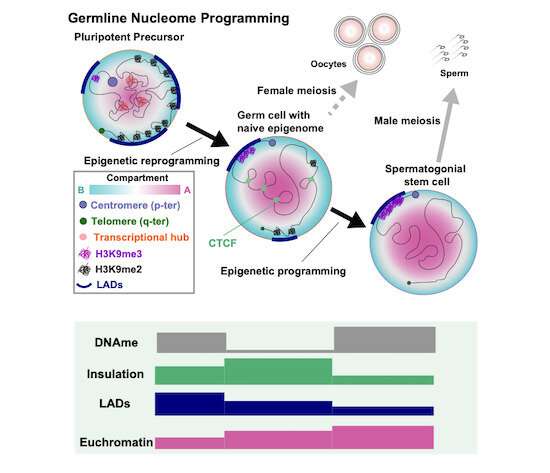Scientists scrutinize changes in germline DNA structure that lay the groundwork for embryo development

Totipotency is the ability of a cell to develop into an individual through elaborate processes of embryogenesis and is created during the development of the precursors of sperm and eggs, which are called germline cells. Understanding the mechanism that ensures totipotency is a key goal of regenerative medicine.
Now a team from Kyoto University's Institute Advanced Study of Human Biology (ASHBi) have gained new insights into how totipotency is programmed into germline cells during their development, ready to be triggered for the generation of sperm and eggs. Their study is published in The EMBO Journal.
Group leader Mitinori Saitou of the ASHBi says, "A developing embryo requires most cells to give up their totipotency as they specialize and grow into different tissues of a newly forming body. But the primordial germ cells of an embryo are unique. In preparation for their future as sperm and eggs, these cells need a mechanism to recover totipotency alongside the other cell functions that lead to fertilization."
To better understand this behavior, Saitou's team followed an in vitro germline differentiation system they created and used a microscope and multi-omics analysis as the cells differentiated into sperm and egg precursors through primordial germ cells. They particularly focused on the 3-dimensional behavior of DNA in the cell nucleus.
They revealed that setting up for a new life cycle first requires a clean wipe of the DNA. All methyl groups, which act as a kind of molecular bookmark for DNA sequences, are removed. The unmarked copy of DNA is thought to be a key feature of germ cells that gives them totipotency.
Strands of DNA in the germ cells are also unwound and made ready for activation, creating a so-called highly "euchromatic" state. But at the same time the nucleus builds in extra insulation with a function of key scaffolding molecules to prevent early and abnormal activation of the DNA.
The team found that in the following steps to form sperm precursor cells, some of these changes were gradually reversed. They confirmed that methyl groups were added back to the DNA strands. But, interestingly, the cell continued to expand the "euchromatic" state of DNA in precursor sperm cells, and the chromosomes also moved toward outer parts of the nucleus, ready for final cell divisions to form sperm cells.
Masahiro Nagano, a leading author of the work, says, "The observed U-turn in DNA methylation while euchromatin formation progresses en route to sperm is an interesting finding. Additionally, we have generated the vast dataset, setting a new benchmark in this field. These findings will have profound meaning for research into inherited disease, fertility, and future stem cell therapies."
More information: Masahiro Nagano et al, Nucleome programming is required for the foundation of totipotency in mammalian germline development, The EMBO Journal (2022). DOI: 10.15252/embj.2022110600
Journal information: EMBO Journal
Provided by Kyoto University




















